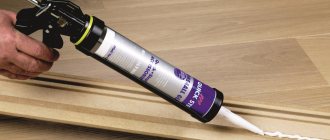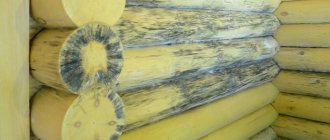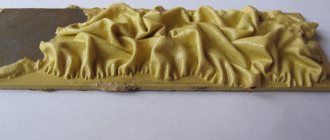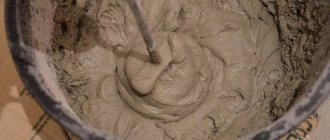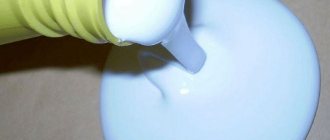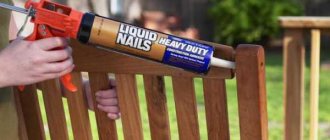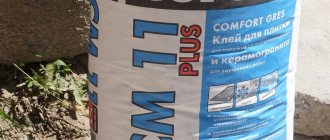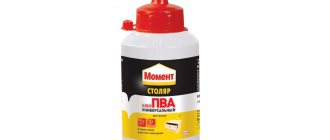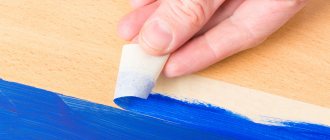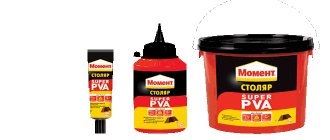In everyday life, at construction sites, and in repair work, various adhesives are often used. Among the products with excellent adhesion, “Moment” stands out - it can glue plastic, glass, metal, wood and many other materials.
During work, glue often gets on your hands or other surfaces. It is difficult to remove dried composition, because it adheres tightly to the base. How to remove Moment glue? There are a number of folk methods and chemical remedies that will help solve the problem.
Difficulty removing glue
“Moment” received its name for a reason - this adhesive composition is instant in setting, quick-drying and very durable. In a few seconds, the glue impregnates the fibers of loose material or firmly adheres to a dense base. This effect is achieved due to the presence of cyanoacrylate and other components - adhesion enhancers. They allow you to reliably fasten even non-porous substrates.
You need to work with Moment or Moment-Crystal glue carefully and always wear gloves. If the product gets on an unintended surface or on your hands, a stain will immediately appear, which is difficult to wash off even when fresh. It is especially difficult to remove drops from clothing and other fabrics. When cleaning, a hole may appear or the material will become rigid, hard, and then begin to crumble along with adhesive drips.
A distinctive property of “Moment” is its resistance to water – cold and hot. Therefore, it will not be possible to simply wash off the dirt without using additional products. The glue is also capable of filling the slightest cracks, pores, and the skin of the hands has a porous structure. This explains the difficulty of removing glue stains from your hands. Sometimes an attempt to break fingers glued together ends in the appearance of a wound. To remove stains, you need to use special methods.
How to use anti-glue
The instructions for using the adhesive remover are simple and clear, and even a beginner who is far from repair work can cope with it. All you need is to apply a thin layer of anti-glue to the contaminated area and wait about an hour. After this time is over, simply wipe off the remaining glue with a dry cloth and look at the result. If the dirt is not completely removed, repeat the procedure again.
Mechanical method
If a trace of glue appears on the skin of the body, hands or surrounding objects, you can first try mechanical cleaning. To slightly reduce the adhesion of “Moment” to the epidermis, you should first steam your hands. To do this, prepare a solution:
- pour hot water into the basin,
- add a little glycerin,
- sprinkle sea salt
- add a teaspoon of citric acid (about 3-4 liters of water).
Place your fingers in the water and hold for 15 minutes. Afterwards it will be easier to remove the glue from the skin. A small stain can be removed by prolonged washing or treatment with pumice. A scrub is also useful; it contains abrasive particles that help cleanse the skin. It is advisable to steam your hands first so that the remnants of the “Moment” are removed faster. We must remember that steamed skin can be easily damaged, so you should be careful when using pumice! After all manipulations, it is recommended to apply a nourishing cream to the skin.
We use improvised means
You can quickly remove glue stains using household products and home methods. For example, jeans and trousers can be placed in the freezer after placing them in a plastic bag. After freezing, the fabric must be carefully cleaned mechanically, and the remaining stains must be washed off by hand with powder. You may need to run the washing machine several times to get rid of the stain completely.
Another option for removing glue stains is to clean the surface with a citric acid solution. Add 20 g of powder to a liter of warm water, pour over the stain, and leave for 20 minutes. Then clean it with a hard sponge and wash it by hand. Instead of acid, it is permissible to use undiluted lemon juice.
There are other home methods to remove glue stains. If we are talking about fabric, it is important to look at the label: delicate materials can deteriorate from the action of certain components, and they can be washed at +20...+30 degrees or in cold water.
Soap solution
The easiest way is to wash a dress or clean a jacket with soapy water. It is necessary to dilute grated laundry soap in warm water so that the solution becomes thick. Place the item in the solution and leave for an hour. Then wash by hand until the stain comes off.
Salt
Salt works as a chemical agent and also acts mechanically as a scrub. Therefore, you can use it to remove the film of Momenta glue from your fingers, clean other areas of the skin, or even wipe off dirt from dishes, containers, tiles, and glass. You just need to take a pinch and rub the stain, after slightly moistening the area. You need to be careful; salt causes skin irritation for some people. After applying salt, rinse the treated area well with water.
Oil
“Moment” removes any vegetable oil well from nails, skin and even teeth. This option is inexpensive and effective, but it cannot be used on fabric or shoes; it cannot remove greasy stains. It is necessary to apply the oil to a cotton pad, wipe the contaminated area, and, if it is skin, leave for 10 minutes. Afterwards, wash off any remaining glue with soap and water. This method is great for cleaning baby's hands. It is also allowed to use fatty baby cream and Vaseline instead of oil.
Vinegar
To clean metal and wooden surfaces, you can use vinegar diluted with water. You need to take the essence, dilute it twice with water, and moisten the brush in the product. Rub the problem area with a brush. You can also pre-wipe the base with a vinegar solution, leave it under the film for 15 minutes, and then clean it. It is also possible to soak things in a vinegar solution that then need to be washed.
What is anti-glue and how is it useful in repairs?
Despite the fact that anti-glue appeared on the construction markets relatively long ago, not many people know about its existence. Just by the name of this product, it becomes clear for what purpose this product was invented. The adhesive remover easily and without harming the coating removes marks from clothing, furniture and other surfaces, so it is not surprising that this product is a faithful assistant when carrying out repairs.
The advantages of anti-glue include:
- Efficiency. The glue remover will quickly destroy traces of dried “Moment”, “Second”, etc. This remover can cope with dirt and traces of glue in 30-40 minutes; in more difficult situations you will have to wait several hours.
- Soft impact. The next advantage of anti-glue, which can easily become an argument in favor of purchasing this product, is its mild effect on the surfaces being treated. You don’t have to worry that when dealing with dried traces of adhesives, the anti-glue will also affect the integrity of the surface. The components in its composition are selected so that the anti-glue acts gently on the contaminated area and does not corrode the top layer of the object.
- Saving. Anti-glue is quite inexpensive. However, saving on its cost is only a drop in the ocean of how much money you will be able to save. If furniture, interior items, finishing materials, etc. are damaged by glue, you will not have to spend money on buying everything new; it is enough to restore the original appearance of objects and surfaces with the help of anti-glue.
Another advantage of anti-glue that I would like to mention is its wide spectrum of action. Anti-glue can be used to clean completely different surfaces, which is especially valuable during repairs.
Anti-glue is very useful when you need to remove residual adhesive from tiles or laminate. In addition, it is used to combat stains on baseboards, window and door openings, marks on repaired furniture, etc.
Application of special chemistry
The most effective method of removing glue is the use of chemicals that are sold in hardware and construction stores.
Solvents
You can clean Moment stains from glass, tiles, and thick fabrics using solvents. You need to buy any organic solvent, moisten a cloth, and carefully wipe the surface of the product. After some time, the stain will go away and its remnants can be removed. When cleaning fabric, it is advisable to test the reaction to the solvent in an inconspicuous area.
Pure gasoline can be used as a means to dissolve the glue. It perfectly removes “Moment” from gloves, work clothes, and unpainted metal. A cotton pad dipped in gasoline is applied to the fabric, left for half an hour, then the product is washed.
Anticlean
“Anti-glue” is a special product that can “unstick” a seam made with almost any glue. It is sold in construction stores. Drop a little Anti-Glue directly from the bottle onto the contaminated area, wait until the reaction occurs, then wipe off the remaining product along with the dissolved Moment. If Anti-Glue was used to clean the fabric, it must be washed thoroughly afterwards. Using this product you can also remove glue from furniture, laminate, and linoleum.
Dimexide
The drug Dimexide is sold in all pharmacies. It not only heals, but is also used in an unconventional way - it dissolves “Moment”, superglue. You need to moisten a cotton pad in Dimexide and wipe metal and wood. The product can also be used to cleanse the skin of your hands, but it must be diluted twice with water.
Acetone
Acetone is a solvent, so it works in a similar way - it dilutes the structure of the glue and disrupts its adhesion to the surface. As a result, after wetting the stain, the glue can be removed with a brush. Typically, acetone or nail polish remover based on it is used to clean synthetic fabrics and metal. It is strictly forbidden to use them on wool, velvet, or natural silk; the items will be irrevocably damaged.
White Spirit
This aggressive solvent is designed to remove oil paint runs. It will also help dissolve the “Moment” if it gets on metal or glass bases. Contact with the body during work should be avoided; all actions should be performed with gloves.
Methods for cleaning different surfaces
How to clean contaminated substrates depends on the type of material from which they are made. Most often you have to remove glue from the skin of your hands, nails, as well as from the table and floor.
How to remove “Moment” from your hands
People who repair shoes at home often encounter the problem of contaminating their hands with Moment. As soon as this happens, you should try to immediately wipe off the glue with oil. Any vegetable oil or butter will do. Rub your hand until the product is completely dissolved; if necessary, use a brush. At the end of the procedure, you need to wash your hands with laundry soap.
The following methods are also used against glue stains on hands:
- Wash by hand. Housewives practice this method against corrosive dirt on their hands. You need to dissolve the powder in water, take any item (preferably unnecessary), wash it thoroughly, working with your hands.
- Acetone. To remove stubborn stains, you can wipe your hands with acetone. It is only important to quickly wash off the solvent from the skin so that it does not have time to cause irritation. For nails, you can use acetone-containing nail polish remover.
- Nail file or for exfoliating skin, pumice. If you act carefully, it is quite possible to “cut off” the glue with a file without harming the skin. The main thing is to rub your hands carefully, without strong pressure.
Washing furniture made of wood, chipboard, MDF
There are similar products in every apartment, so during the renovation process they can get dirty with glue. Nail polish remover and acetone are excellent for removing marks from wooden surfaces. You just need to wipe the base with a sponge soaked in such substances. You cannot use acetone only on varnished surfaces; it is better to wash them carefully with laundry soap.
Fabrics and shoes
Use gasoline or acetone to remove Moment stains from coarse, thick fabrics, with the exception of wool. Wipe the material with a sponge soaked in such solvents. First, it is better to test the effect of the products on inconspicuous areas. Delicate fabrics should be washed with a solution of citric acid and wiped with lemon juice. After removing most of the glue, you can wash the item in the washing machine.
You can also remove stains in the following ways:
- freeze the product in the freezer, then remove the glue with nail clippers,
- attach paper to the item, iron it, the glue will be absorbed into the sheet after melting,
- take the item to the dry cleaner.
“Moment” is wiped off from the sole of the shoe using a cloth soaked in Dimexide or “Anticle”. From the outside, shoes can be cleaned with alcohol, mechanically (with a special brush), and washed with soapy water.
Washing the floor
When working with glue, drops of it can get on parquet, laminate, linoleum. Of course, you should initially cover the floor so as not to damage it, but if there is a problem, you can wash off unsightly marks with white spirit, Dimexide, or Anti-Glue. For parquet, it is better to use Dimexide diluted with water in half.
Metal cleaning
Metal surfaces can be cleaned of glue using acetone and acetone-based liquids. Gasoline, vinegar, and white spirit will also not harm unpainted metal. For painted products, it is better to use alcohol or vodka. The remains of the softened “Moment” can be cut off with a blade, a stationery knife, or cleaned off with salt or other abrasive.
Plastic laundering
It is difficult to remove glue from plastic, because this material is soft and has excellent adhesion to various adhesives. It is best to use the following methods:
- moisten a cotton pad with boiling water, apply to the stain, cover the top with cellophane, after an hour, cut off the glue or carefully clean with a brush,
- make a soap solution, thoroughly rinse the area of contamination with a hard sponge and the prepared product,
- rub the area where the glue appears with alcohol, you can wait a while for the product to better soften,
- dissolve the glue with Dimexide, then wipe off the remaining residue with salt.
On some types of plastic you can use white spirit or acetone; there will be no harm to the surface, but you need to first check the reaction from an inconspicuous edge of the product.
Glass cleaning
Glue is removed from glass bases with vegetable oil. You can also use a detergent in powder form, salt, or baking soda. For glass surfaces it is permissible to use kerosene, acetone, and gasoline. Crystal products are effectively cleaned with ammonia.
What can be glued with Cyanoacrylate?
In this case, in addition to the glue itself, a special hardener is used, upon interaction with which the cyanoacrylate quickly polymerizes. The main feature of the 2-component composition is that this superglue can be used to glue metal, stone and glass, that is, moisture-proof materials.
Interesting materials:
How to arrange a 10 sq. m bedroom? How to beat a beam in the interior? How to clean coins? How to register as a manicurist? How is an income certificate prepared? How is baggage paid on the plane? How is child care paid? How is sick leave paid after? How is sick leave paid in a hospital? How is sick leave paid in kindergarten?

